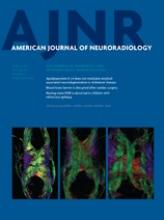Abstract
BACKGROUND AND PURPOSE: There are few articles characterizing cerebellar lesions in patients with TSC and no published series documenting longitudinal evaluation of these lesions, to our knowledge. Recent suggestion of a correlation between autism and cerebellar lesions in patients with TSC heightens the importance of understanding these lesions. Our purpose was to characterize cerebellar lesions in a cohort of young patients with TSC with specific interest in assessing longitudinal changes.
MATERIALS AND METHODS: We retrospectively reviewed MR images from 145 pediatric and young adult patients with tuberous sclerosis (mean age, 7.6 years). A number of imaging characteristics of cerebellar tubers were recorded, and patients were evaluated for SGAs. Patients with follow-up scans >3 months from the original scan were further analyzed for longitudinal tuber characterization.
RESULTS: There were 24.1% of patients with focal cerebellar lesions; 52.4% of patients with cerebellar lesions demonstrated change in imaging characteristics during longitudinal analysis. Fifty-one percent of the lesions were enhanced after gadolinium administration. Twenty percent of the patients with cerebellar lesions had pathologically confirmed SGAs compared with the incidence of 11% in the 145 patients with TSC reviewed.
CONCLUSIONS: In our large cohort of young patients with TSC, cerebellar tubers were common and 52% of patients had tubers that changed with time. A higher percentage of patients with cerebellar lesions developed SGAs than patients with TSC without cerebellar lesions. Because this is the first reported longitudinal study of cerebellar lesions in TSC, further investigation may provide additional insight into TSC pathology and associated clinical manifestations, such as autism, developmental delay, and seizures.
ABBREVIATIONS:
- SENs
- subependymal nodules
- SGAs
- subependymal giant cell astrocytomas
- TS
- tuberous sclerosis
- TSC
- tuberous sclerosis complex
- © 2013 by American Journal of Neuroradiology












